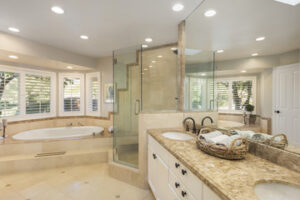Kitchen Remodel Tacoma can increase your home’s value and transform your space into the perfect cooking and entertaining area. However, these projects can be expensive and require a substantial investment of time.

Be realistic about your budget and include a contingency fund. Splurge strategically on the items that will have the most impact and cut costs where possible.
One of the biggest determining factors in a kitchen remodel is the budget. While some homeowners are tempted to spend more than they can afford in hopes of boosting their home value, this is rarely a wise financial decision. Generally speaking, kitchen upgrades that cost less than 10% of your home’s overall value offer the best return on investment.
Labor accounts for a huge chunk of kitchen remodeling costs, so it’s important to find a remodeler who is willing to work within your budget and help you cut expenses where possible. For example, painting your own cabinets, refacing existing ones or using particleboard instead of plywood where it won’t be seen can make a big difference in the final cost of a project.
Countertops are another major expense, and while granite is still the popular choice among many homeowners, there are more budget-friendly options like Corian, concrete or laminate. Flooring is also an important cost to consider. Vinyl, linoleum and laminate flooring is cheaper than hardwood or natural stone tile but still provides a modern look.
It’s also a good idea to leave at least 20% of your kitchen remodeling budget in reserve for unanticipated costs. You may encounter costly surprises such as plumbing or electrical issues that were not discovered prior to tearing out walls, or you might need to run water or electricity lines to an area of your kitchen that was previously not planned on.
Design
Once a budget is set and the scope of the remodel is determined (whether it’s a cosmetic makeover or a gut job), a design plan can be created. Designers offer many services, from simple sketches and computer-aided drafting to 3D animation and virtual reality. Some designers charge a flat fee, while others may include their designs in the cost of certain products, such as cabinets or appliances. Be sure to ask about these costs when interviewing professionals.
A mid-size kitchen remodel usually starts with demolition, or “demo,” which exposes the walls and subfloor, allowing for utility work like new drywall and changes to plumbing and electrical circuitry (if necessary). Next, framing changes are made, including adding windows, moving or removing walls and possibly extending ductwork.
When the wall structure is ready, the installation of cabinets and countertops begins. Depending on the size of the room, this can be a major undertaking that requires heavy equipment and professional help.
This is also the time to decide on the materials for the kitchen. Countertops are an expensive element, and choosing a material that is not only durable but that fits with the design can be a difficult choice. For example, a bold backsplash can be fun, but it may not work with a tile floor or with your paint color scheme. Keeping it in mind will ensure that your remodel looks cohesive and intentional.
Layout
The layout of your kitchen is a vital part of a successful remodel. You want to be sure it is functional and fits the needs of your family. A good designer or contractor will be able to assess your current space and advise you on whether it is working well or can be improved by changing the layout.
There are a number of different layouts to choose from, including galley kitchen designs, L-shaped kitchens and U-shaped designs with a peninsula. Each has its pros and cons. You also need to take into consideration natural light. For example, if you have windows in your kitchen you need to be sure that they are properly placed to maximize light and allow for the best workflow.
Another factor that influences the layout of your kitchen is how it will be used. Your designer can help you decide which layout will be most appropriate for your family’s unique lifestyle and work habits. This will involve examining how your family uses the kitchen, such as who cooks most often, does anyone entertain in the home and if there are any members of the family with special needs that may require adaptations.
A fresh kitchen layout can make a huge difference to the way your kitchen works. It can prevent tripping hazards and improve workflow. The goal is to create a practical, functional space that meets your family’s needs and fits seamlessly with the rest of your home design.
Materials
When it comes to kitchen remodels, the materials you choose will have a huge impact on your project’s success. It’s important to consider all your options and budget carefully when choosing cabinets, sinks, countertops and backsplashes, floors, lighting, and appliances.
Cabinetry is a big part of the total cost, and it’s critical to choose durable materials that will stand up to moisture and daily wear and tear. For example, plywood resists water effectively and is easy to repair if damage occurs. However, it may not be as attractive as solid wood.
Countertops are another major investment, and it’s worth focusing on quality to get the most value out of your dollar. Look for granite or quartz that will withstand stains, acidic liquids and everyday wear and tear. Other natural stone materials like slate, travertine and limestone are also gaining popularity. If you’re on a tighter budget, try a poured concrete countertop that can be customized to fit your space or a more affordable porcelain option.
Backsplashes are a great way to add a splash of color or texture to your kitchen, and they’re also an effective way to protect the walls from grease and grime. They can also be used to create a custom design element, such as a unique pattern or a backsplash that incorporates the same material as your countertop. Also, don’t forget to consider energy-efficient appliances that can help lower your utility costs.
Appliances
A new kitchen can transform the heart of your home and make it a place you want to spend time in. Often a remodel includes new appliances, but it can also include changes to the layout and organizational changes. The appliances you select can significantly impact your remodeling costs. Some of the factors you will be weighing when choosing appliances include energy efficiency, quality, price and warranty. If you’re planning on purchasing a new refrigerator, dishwasher, cooktop or oven, it is best to start shopping early in the remodeling process.
Kitchen remodeling can be a great opportunity to upgrade your appliances to more eco-friendly models. While these devices may be pricier upfront, they offer long-term savings in energy bills. Another option is to consider using sustainable materials for your flooring, cabinets or countertops. These options will add value to your home and attract homebuyers if you decide to sell it in the future.
Choosing the right appliances for your remodeled kitchen can be challenging. You will need to decide on a design, color and style that fits your aesthetic. You can find a variety of different styles, colors and sizes of kitchen appliances online or at a local store. It is recommended to consult a Kowalske designer, who can show you the most popular products and colors. In addition, you will need to consider the size of your kitchen, the amount of storage space and the electrical requirements of your appliances.
Financing
A kitchen remodel can require significant financial investment. Depending on the scope of your project, it can range from what Ariana Lovato calls a “basic cosmetic refresh” to a complete overhaul that involves tearing down walls and reconfiguring the layout (which may necessitate permits).
To determine the best financing options for your kitchen renovation, consider the total cost of the project, how long you intend to finance the loan, and the repayment schedule. It’s important to keep in mind that credit cards limit you to a maximum lending amount, and carrying a balance may incur costly interest or annual fees. In addition, credit card debt can affect your credit score, so you’ll want to make sure that you select an affordable borrowing option that will allow you to repay the loan over time.
Personal loans and home equity loans/lines of credit are more flexible options. They typically have lower interest rates than credit cards, and they can be used for any type of improvement project. However, they are secured by your home, so you’ll need to have sufficient equity to qualify and you may be required to have cash on hand for closing expenses.
Finally, several government programs offer loans or grants for homeowners who are remodeling their homes. These typically come with strict eligibility requirements, and they can be more time consuming to apply for. Once you’ve decided how to finance your kitchen renovation, prepare any necessary documentation and submit your application.


